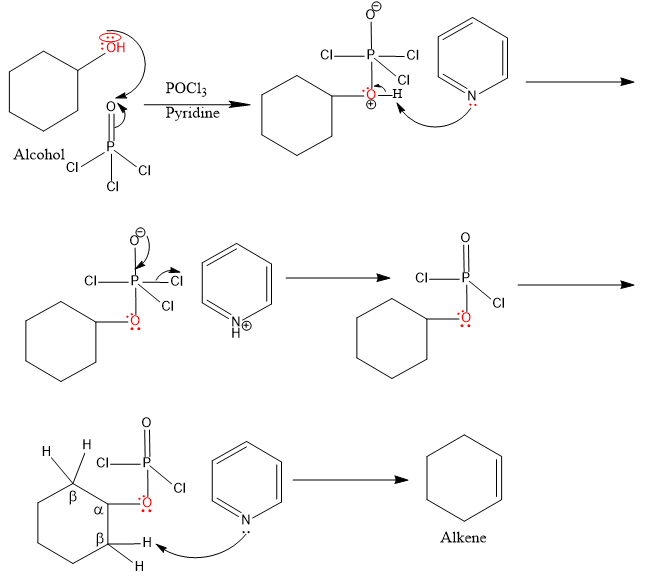
Answer
428.1k+ views
Hint: An attempt to this question can be made by determining the reaction mechanism for dehydration using both the reagents $POC{{l}_{3}}$ and${{H}_{2}}S{{O}_{4}}$. Now determine the difference in the mechanism. With this you can reason why $POC{{l}_{3}}$ is preferred over ${{H}_{2}}S{{O}_{4}}$ for dehydration.
Complete step by step answer:
So in the question it is asked that, we have to select
We will write the reaction mechanism for dehydration using $POC{{l}_{3}}$.

In the above reaction we observe,
- No carbocation formation
- Nucleophilic attack used for deprotonation
- involves E2 mechanism as pyridine base abstracts proton from the adjacent carbon as the same time at which $-\text{OPOC}{{\text{l}}_{2}}$ is leaving
- involves $\text{R}-\text{OPOC}{{\text{l}}_{2}}$ with $-\text{OPOC}{{\text{l}}_{2}}$ as a better leaving group
Based on the above statements we can conclude that the below given options stand correct.
(A) It does not involve carbocation.
(B) It involves the species $\text{R}-\text{OPOC}{{\text{l}}_{2}}$ with $-\text{OPOC}{{\text{l}}_{2}}$ as a better leaving group.
(C) It involves E2 mechanism as the pyridine base abstracts proton from the adjacent carbon as the same time at which $-\text{OPOC}{{\text{l}}_{2}}$ is leaving.
The correct answer is option “A, B and C” .
Note: The reaction with sulfuric acid on the other hand involves the formation of carbocation. This is a slow step. Along with that it uses the E1 mechanism for elimination unlike $POC{{l}_{3}}$ that uses the E2 mechanism for elimination.
Complete step by step answer:
So in the question it is asked that, we have to select
We will write the reaction mechanism for dehydration using $POC{{l}_{3}}$.

In the above reaction we observe,
- No carbocation formation
- Nucleophilic attack used for deprotonation
- involves E2 mechanism as pyridine base abstracts proton from the adjacent carbon as the same time at which $-\text{OPOC}{{\text{l}}_{2}}$ is leaving
- involves $\text{R}-\text{OPOC}{{\text{l}}_{2}}$ with $-\text{OPOC}{{\text{l}}_{2}}$ as a better leaving group
Based on the above statements we can conclude that the below given options stand correct.
(A) It does not involve carbocation.
(B) It involves the species $\text{R}-\text{OPOC}{{\text{l}}_{2}}$ with $-\text{OPOC}{{\text{l}}_{2}}$ as a better leaving group.
(C) It involves E2 mechanism as the pyridine base abstracts proton from the adjacent carbon as the same time at which $-\text{OPOC}{{\text{l}}_{2}}$ is leaving.
The correct answer is option “A, B and C” .
Note: The reaction with sulfuric acid on the other hand involves the formation of carbocation. This is a slow step. Along with that it uses the E1 mechanism for elimination unlike $POC{{l}_{3}}$ that uses the E2 mechanism for elimination.
Recently Updated Pages
Who among the following was the religious guru of class 7 social science CBSE

what is the correct chronological order of the following class 10 social science CBSE

Which of the following was not the actual cause for class 10 social science CBSE

Which of the following statements is not correct A class 10 social science CBSE

Which of the following leaders was not present in the class 10 social science CBSE

Garampani Sanctuary is located at A Diphu Assam B Gangtok class 10 social science CBSE

Trending doubts
A rainbow has circular shape because A The earth is class 11 physics CBSE

Which are the Top 10 Largest Countries of the World?

Fill the blanks with the suitable prepositions 1 The class 9 english CBSE

How do you graph the function fx 4x class 9 maths CBSE

What is BLO What is the full form of BLO class 8 social science CBSE

The Equation xxx + 2 is Satisfied when x is Equal to Class 10 Maths

Give 10 examples for herbs , shrubs , climbers , creepers

Difference between Prokaryotic cell and Eukaryotic class 11 biology CBSE

Change the following sentences into negative and interrogative class 10 english CBSE





